Did you know nearly 70% of people face chronic stress-related health issues? This shows the need for effective wellness methods like Panchakarma therapy. Known as “five actions,” it’s an ancient Ayurvedic detox. It cleanses the body and brings balance.
In this article, we’ll explore what Panchakarma therapy offers. We’ll look at its history, health benefits, and more. Join us on a journey to optimal wellness.
What is Panchakarma Therapy?
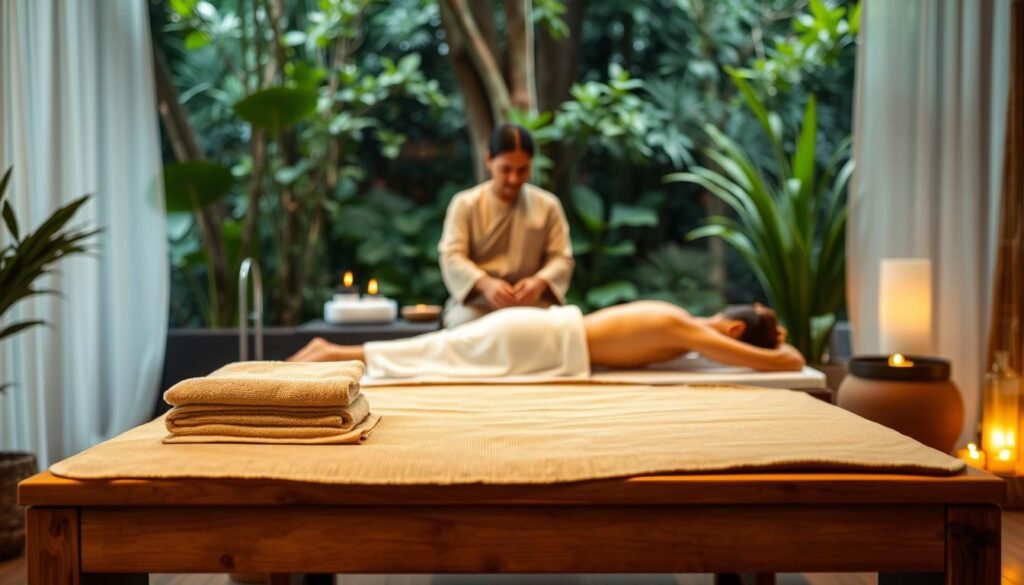
Panchakarma therapy is a deep ayurvedic purification process. It aims to remove toxins, called “Ama,” from the body. This detoxification treatment focuses on balancing the three doshas—Vata, Pitta, and Kapha—to ensure health.
It uses herbal remedies, changes in diet, and massages to rejuvenate the body. This helps restore balance and promotes wellness.
This ancient healing practice is key to supporting holistic health. It helps us understand the importance of balance in our bodies.
The Historical Significance of Panchakarma

Panchakarma therapy is a key part of the ayurvedic tradition. It’s one of the oldest healing practices worldwide. With roots going back nearly 5,000 years, it focuses on overall health and balance.
Old texts like the Charaka Samhita highlight its importance. They show it’s for preventing disease, rejuvenation, and living a long life. This ancient method treats illnesses by fixing body imbalances.
Panchakarma’s lasting impact shows ancient Indians valued preventive care. Today, its wisdom helps us stay well in our fast-paced world.
Understanding Ayurvedic Detoxification

Our journey to holistic wellness starts with an ayurvedic detox. This process removes toxins built up in our bodies. These toxins come from our lifestyle, diet, and stress. Knowing about Ayurvedic cleansing helps us see how it affects our health.
The detox treatment aims to balance our body. It focuses on boosting our digestive fire, or Agni. A strong Agni helps us digest food and emotions better, getting rid of what’s not good for us.
Trying this ancient practice teaches us a lot about our bodies. It helps us heal and feel new again. Understanding detox helps us see that a clean body means a clear mind.
| Aspect | Ayurvedic Detox | Conventional Detox |
|---|---|---|
| Approach | Holistic focus on body balance | Focused on rapid results |
| Methods used | Herbs, dietary adjustments, lifestyle changes | Juices, supplements, fasting |
| Duration | Typically longer for gradual change | Short-term intensive treatments |
| Outcomes | Long-lasting health benefits | Temporary weight loss or energy boost |
Choosing an ayurvedic detox leads to lasting health and energy. It shows our dedication to a balanced life. Let’s dive into this journey together, using Ayurvedic wisdom to improve our well-being.
The Five Actions of Panchakarma
![]()
Panchakarma is a key part of ayurvedic detox. It uses five main actions to improve health and wellness. These actions are vital for detoxification and rejuvenation.
- Vamana: Known as the vomiting therapy, Vamana is effective for Kapha imbalances. It removes excess mucus and phlegm, cleaning the respiratory system.
- Virechana: This purging method targets Pitta excess in the body. It removes toxins through the digestive system, helping with acid reflux and inflammation.
- Basti: Enema therapy cleanses the colon, improving gut health. It’s often used with herbal oils for better results.
- Nasya: This nasal therapy uses oils and powders to clean the nasal passages. It benefits the head and neck, improving mental clarity and breathing.
- Raktamokshana: Bloodletting is a unique method that targets blood toxins. It rejuvenates the blood, boosting energy and vitality.
Panchakarma offers a holistic approach to wellness. It addresses physical, mental, and emotional health. Adding mud therapy can make the experience even more relaxing and healing.
Panchakarma Therapy: What to Expect and How It Works
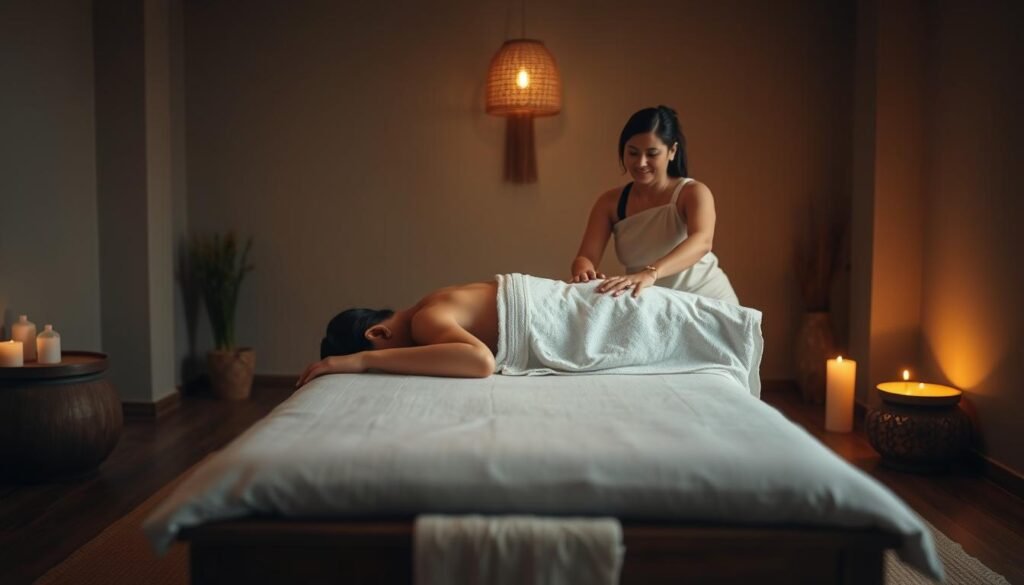
Starting panchakarma therapy is a journey of change. It’s not just about cleaning the body. It’s a ritual that heals the body, mind, and spirit.
When you arrive at a panchakarma retreat, you meet with an Ayurvedic expert. They create a plan just for you. This ensures the treatment meets your health needs and lifestyle.
At the retreat, you’ll follow a detailed plan. You might get oil massages, steam treatments, and herbal remedies. You’ll also eat foods that support your health, following the ayurvedic way.
By the end, you’ll feel refreshed and renewed. Panchakarma therapy boosts your physical and mental health. It’s a journey that brings immediate benefits and helps you stay healthy for the long term.
Health Benefits of Panchakarma Therapy
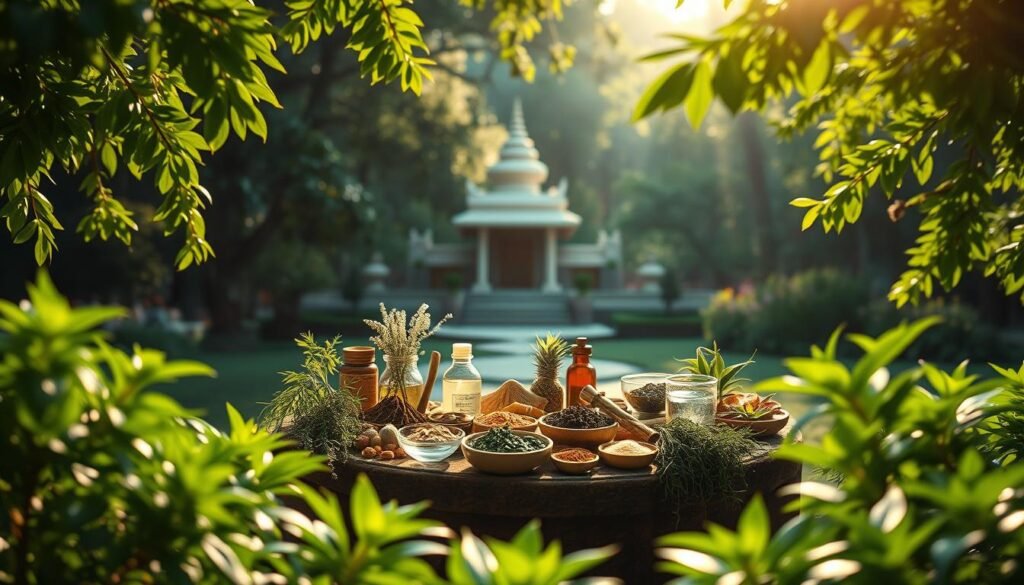
Panchakarma therapy is a unique way to achieve holistic wellness. It involves a deep cleansing process based on ancient Ayurvedic practices. This therapy cleanses the body, mind, and soul, leading to rejuvenation and increased vitality.
People who try Panchakarma often feel refreshed and emotionally balanced. This is because it helps balance the three doshas in the body. Balancing these energies prevents health issues caused by imbalances.
Boosting the immune system is another key benefit of Panchakarma. Regular treatments can make our immune system stronger. This helps us fight off diseases better. By removing toxins and improving metabolism, our bodies can thrive, making us feel more alive every day.
The Stages of Panchakarma Treatment
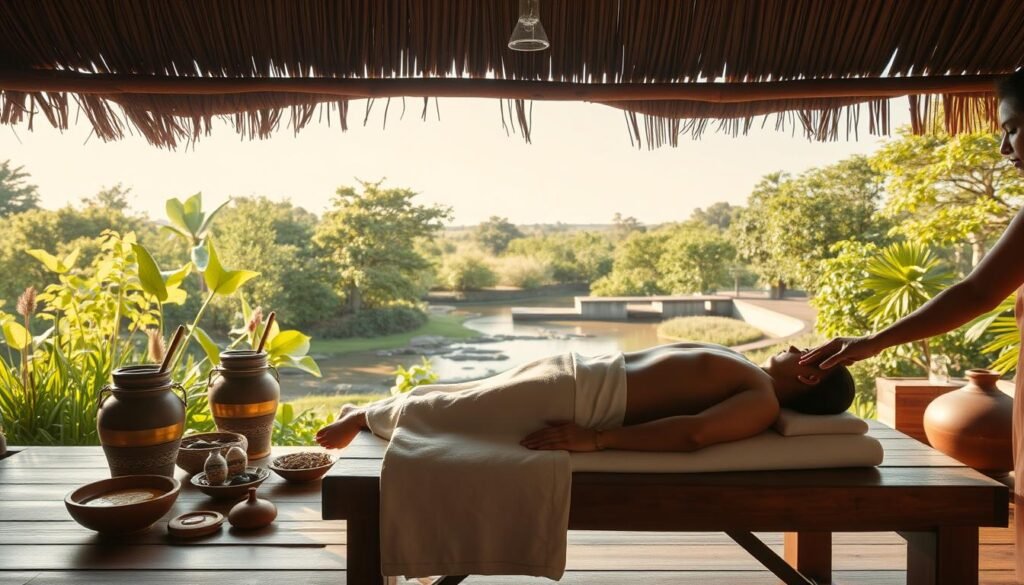
Panchakarma therapy is a detailed ayurvedic treatment with different stages. Each stage is important for a complete detoxification process. Knowing these stages helps us see how this ancient practice boosts health and wellness.
The first stage is all about getting ready. It includes oiling (Snehana) and sweating (Svedana). These steps help loosen toxins and make it easier for the body to get rid of waste. By using special oils, practitioners help move toxins, preparing for deeper cleansing.
The next stage focuses on the main cleaning actions. It uses five main methods to remove toxins from the body. Each method works with different body processes, making systems work better and balance.
After the main treatment, the post-panchakarma care is key. This stage is all about getting back to health. It involves changing diet and lifestyle. The aim is to rebuild strength, improve digestion, and keep the doshas in balance. This is vital for staying healthy and full of energy.
| Panchakarma Stage | Description | Key Focus Area |
|---|---|---|
| Preparatory | Involves oiling and sweating to loosen toxins. | Toxin Elimination |
| Primary Purification | Involves five core methods for detoxifying the body. | Toxin Expulsion |
| Post-Care | Emphasizes rejuvenation through diet and lifestyle changes. | Strength Restoration |
Key Techniques in Panchakarma Therapy
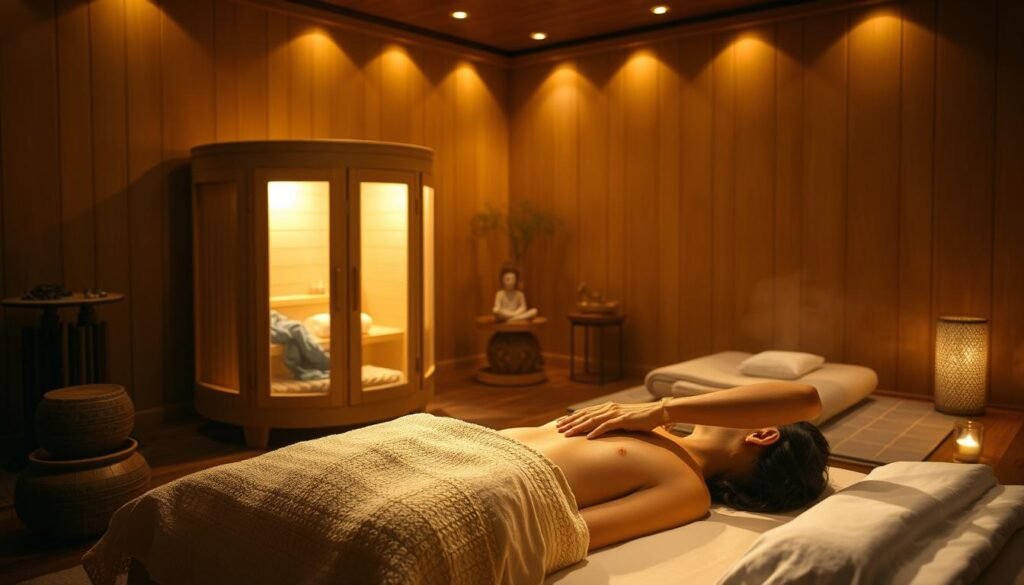
Panchakarma therapy uses many important techniques to detox and improve overall health. These methods work together to clean the body and refresh the mind.
Emesis Therapy helps get rid of toxins from the upper body and digestive system. It’s best done in certain seasons, helping those with Kapha imbalances the most.
Virechana uses herbal laxatives to remove excess Pitta from the liver and intestines. It’s done in the late morning after other treatments.
Basti, or enema therapy, cleanses the colon with medicated substances. It’s great for Vata imbalances, improving health over time.
Nasya involves putting therapies in the nose to clear and refresh the head and neck. It helps with sinusitis and improves senses.
Lastly, Raktamokshana, or bloodletting, removes a small amount of blood to purify the blood. It’s good for skin problems linked to Pitta, helping achieve long-term wellness.
What to Expect During a Panchakarma Retreat
A panchakarma retreat is a journey of deep healing and rejuvenation. Upon arrival, you enter a serene space that encourages relaxation and self-reflection. Each retreat offers personalized detox treatments, tailored to meet your health needs.
At an ayurvedic wellness retreat, a day is filled with therapeutic sessions. You’ll enjoy herbal oil massages, steam treatments, and chanting sessions. These therapies are given by experts in Ayurveda. Yoga and meditation are also part of the detox journey.
The retreat also provides meals that follow Ayurvedic dietary practices. These meals nourish your body and support the detox process. The focus is on whole, organic foods to cleanse toxins and boost energy.
During the retreat, you connect with others and yourself. This creates a sense of community. The combination of therapies, diet, and reflection helps restore your health fully.
| Activity | Description | Benefits |
|---|---|---|
| Herbal Oil Massage | Therapeutic massage using warm herbal oils tailored to body types. | Relaxes muscles, enhances circulation, promotes detoxification. |
| Steam Treatments | Use of steam to induce sweating and facilitate toxin release. | Cleanses the skin, opens pores, enhances metabolism. |
| Yoga & Meditation | Practices focused on breath control and mindful movement. | Improves mental clarity, reduces stress, promotes emotional balance. |
| Ayurvedic Meals | Wholesome, organic meals prepared according to Ayurvedic principles. | Supports digestive health, nourishes body, aids detoxification. |
Attending a panchakarma retreat is a journey of renewal. It emphasizes the importance of self-care and wellness through ancient practices. You leave feeling rejuvenated, both physically and mentally, with the knowledge to maintain your well-being.
Foods and Diet for Panchakarma
The ayurvedic diet is key during Panchakarma. It helps detoxify and boosts wellness. Foods chosen are easy to digest and full of nutrients.
A good detox meal plan is essential. It includes kitchari, a mix of rice and lentils, and warm soups. These foods help the body get rid of toxins. Avoiding heavy, processed foods keeps the body balanced.
Understanding your dosha is important during Panchakarma. Foods are picked for their health benefits and how they balance the body and mind. Eating plants like vegetables, grains, and good oils is best. This careful choice makes Panchakarma more effective.
Choosing a Qualified Ayurvedic Practitioner
When starting panchakarma therapy, picking a skilled ayurvedic practitioner is key. They ensure your treatment is safe and effective. A certified expert knows how to tailor treatments to fit your health needs perfectly.
Ask about the practitioner’s qualifications and experience during an ayurvedic consultation. It’s also good to check if they know a lot about panchakarma. Reading testimonials or asking for referrals can show how well they work with clients.
Choose practitioners linked to well-known ayurvedic schools. This shows they follow high standards. A first meeting can help you see if their way of working fits your healing path.
Contraindications for Panchakarma Therapy
Panchakarma therapy is great for health and well-being. But, there are some contraindications to think about. Some people might find it hard to do this detox process.
Children and pregnant women should not do Panchakarma. It could harm their bodies. Also, people with serious illnesses or health problems need to talk to their doctor first.
Knowing the panchakarma restrictions helps make wellness safer and more personal. It’s key to think about each person’s health. This way, Ayurvedic wellness fits their unique needs.
Panchakarma Therapy in Modern Wellness Practices
Panchakarma in wellness is gaining popularity as people look for natural ways to improve their health. This ancient Ayurvedic tradition is becoming more relevant in today’s wellness world. It offers a deep approach to detox and rejuvenation.
Wellness centers are now embracing Panchakarma, showing its growing appeal. It’s seen as a natural choice over traditional detox methods. Retreats that offer Panchakarma focus on personalized care, making it effective in our busy lives.
Organizations focused on holistic health are adding Panchakarma to their offerings. They see its benefits for both body and mind. People get tailored programs that help with specific health issues and aim for overall balance.
Panchakarma is a key player in the search for well-being, blending old traditions with today’s needs. It helps us live healthier and understand what it means to be truly well.
Integrating Panchakarma into Your Wellness Routine
Adding panchakarma to our wellness routine can greatly improve our health. This ancient practice focuses on detoxifying the body and mind. It helps us feel refreshed and balanced.
We can start by eating mindfully and doing seasonal cleanses. These steps help our body stay in tune. Adding herbal teas, breathing exercises, and self-massage to our routine is also beneficial.
Next, we might consider professional panchakarma sessions. These include oil therapies and steam treatments. They offer a deeper cleanse and a relaxing experience. Committing to panchakarma can change our health journey for the better.
Finding the Right Ayurvedic Wellness Retreat for Panchakarma
Choosing the right ayurvedic wellness retreat is key for a true Panchakarma experience. The retreat should be a place of healing and renewal. It should make your treatment more effective. Look for retreats that offer personalized panchakarma options.
When searching, focus on retreats with certified Ayurvedic experts. Reading patient reviews can give you a feel for the retreat’s vibe. A supportive environment is vital for a successful detox retreat.
Here are some important things to consider:
- Certification of Practitioners: Make sure the staff is well-trained in Panchakarma.
- Comprehensive Care: Choose packages that include meals, therapies, and consultations.
- Positive Reviews: Check out what past guests have to say.
- Serene Location: Pick a retreat in a peaceful spot for better relaxation.
By considering these points, you’ll find a retreat that fits your needs and supports your Panchakarma journey well.
Common Misconceptions About Panchakarma Therapy
Panchakarma therapy is often misunderstood. Many think it’s just a fancy spa treatment, not a deep holistic practice from Ayurveda. The relaxing atmosphere of wellness retreats is nice, but Panchakarma is more than that. It uses special techniques to balance the body and mind.
Some believe Panchakarma is only for the sick. But it’s actually for everyone to stay healthy. It helps remove toxins and balance, keeping us well and full of energy.
There’s also confusion about how long and intense Panchakarma is. People might think one session is enough or that it’s too harsh. But, it really needs a custom plan that can last days or weeks. Knowing this helps us see the real value of Panchakarma in improving our health.




